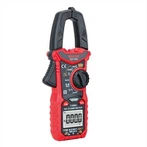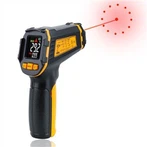Problems and solutions encountered in actual maintenance of frequency converter switching power supply:
1. Delta frequency converter (fault phenomenon: no display when powered on)
After testing, it was found that the main circuit of the power supply, charging resistor, and main circuit contactor were all normal, so it was determined that the switch power board was faulty. Follow the above maintenance steps to measure the switch power board. During the first step of measurement, it was found that the 330K Ω/2W voltage drop resistance between the DC bus 560V and the PWM modulation chip was damaged. The nominal resistance of 330K Ω/2W was measured to be above 2M Ω, so the PWM modulation chip could not receive the power to start, so it could not start and work. To be cautious, key components such as switch tubes, transformers, rectifier diodes, and filter capacitors were also tested. After confirming that there were no issues, the power on test was conducted, and it was OK! The switch power supply vibrates, and the output voltage of each group is normal. After installing the frequency converter, the startup test is normal. This frequency converter has been repaired (note: maintenance personnel must develop a habit during maintenance: do not rush to replace the faulty components for testing, be sure to test all high-power and easily damaged components, and try the machine again after confirming that there are no problems, which is both safe and safe).
2. Tai'an frequency converter (fault phenomenon: no display when powered on)
After testing, it was found that the main circuit of the power supply, charging resistor, and main circuit contactor were all normal, and the fault was determined to be on the power board. Follow the repair steps to measure the switch power board.
The first step of measurement passed, and during the second step of measurement, it was found that the c-e junction of the switch tube had broken down. It was removed, and then key components such as the transformer, rectifier diode, and filter capacitor were tested. After confirming that there were no problems, the power on test was conducted, and the output voltage of each group was normal. The installation test was normal, and the fault was eliminated.
3. Siemens frequency converter (fault phenomenon: no display when powered on)
After testing, it was found that the main circuit of the power supply, charging resistor, and main circuit contactor were all normal, and the fault was determined to be on the power board. Follow the repair steps to measure the switch power board.
The first step passes the measurement, the second step passes the measurement, the third step passes the measurement, the fourth step passes the measurement, and then the power board is separately powered to measure that the power terminal of the PWM modulation chip has a voltage of about 12.5V to the ground, indicating that the power supply is normal. Using an oscilloscope to observe the PWM output terminal of the chip, it was found that there is no PWM modulation waveform. After replacing the PWM modulation chip, the power on test was normal and the fault was resolved.
4. Schneider frequency converter (fault phenomenon: no display when powered on)
After repeatedly burning the switch tube, it was found through testing that the main circuit, charging resistor, and main circuit contactor of the power supply were all normal, and the fault was determined to be on the power board. Follow the repair steps to measure the switch power board.
The first step passed the measurement, the second step found a breakdown of the switch tube, the third step passed the measurement, and the fourth step passed the measurement. Replace the switch tube with a new one, and separately power on the power board, but the tube burned again. After removing the switch tube, do not install the tube. Conduct a power on test and measure that the power terminal of the PWM modulation chip has a voltage of about 12V to ground, which is also normal. Using an oscilloscope to observe the PWM output terminal of the chip, it was found that the PWM wave was only about 5-6 KHZ. After power outage, the timing component was removed for measurement and it was found that the resistance value of the timing resistor increased. After replacing the timing resistor and switch tube, the power was turned on normally and the power tube was no longer burned. The fault was resolved.
5: Lenz frequency converter (fault phenomenon: no display when powered on)
Repeatedly burning the switch tube, follow the maintenance steps to measure the switch power board.
The first step passed the measurement, and during the second step, it was found that the c-e junction of the switch tube was broken. The third, fourth, fifth, sixth, and seventh steps all passed the measurement. Install a new switch tube and conduct a power on test. As the voltage of the voltage regulator increases, you can hear a squeaking sound, which is a bit noisy. After adjusting the voltage to the rated voltage, the output voltage is measured to be lower than the normal value. Within 2 minutes, suddenly a burning smell is smelled, and the fuse is broken. Quickly cut off the power and it is found that the switch tube is very hot to the hand. The measurement shows that it has already been broken. Remove the switch tube for power-on test, measure the voltage between the power supply end of the PWM modulation chip and the ground at around 12V. Use an oscilloscope to observe the PWM output end of the chip, and it is found that there is a PWM wave output with a frequency of around 30 KHZ, which is also normal. Therefore, I suspect that the quality of the newly replaced switch tube is not good. I replaced it with another one and conducted a power on test. As a result, the tube was burned again. After the power was cut off, I accidentally touched the component of the absorption circuit and found it to be hot. However, it was normal during the measurement, so I tested it again and it was still normal. Simply dismantle the absorption circuit and replace it with a tube for power on testing. It was found that the squeaking sound of the transformer was reduced, and the output voltage of each group was measured to be normal. After running for 20 minutes, the switch tube did not burn again. After the power was cut off, the touch switch tube was slightly hot, indicating a normal heating state. Therefore, it was determined that the fault was in the absorption circuit, and the absorption circuit components were replaced to eliminate the fault.










